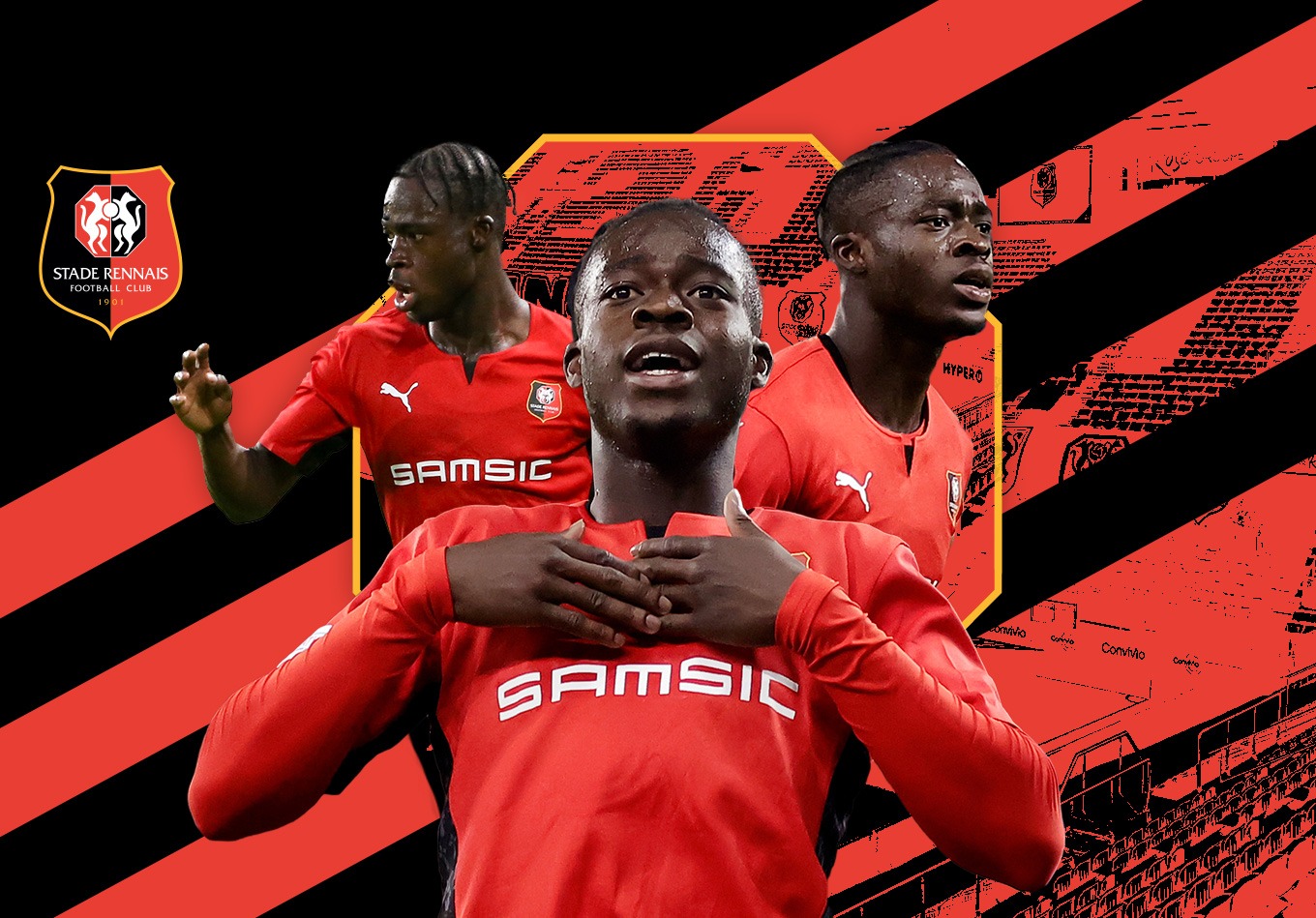What makes an entertaining footballer? Ask a set of football fans, and you get many different answers. Some may put dribbling and skill with the ball towards the top of the list, others may demand entertaining goals, and there may even be someone whose self-actualisation needs are fulfilled by watching Peter Crouch do the robot dance. Whatever criteria you might come up with, few players tick as many boxes as Kamaldeen Sulemana.
He’s a player who has the capacity to score a goal like this, with that skill and with that finish, and to leave any commentator hollering:
He’s probably also a YouTube player compilation video-maker’s dream youngster. When you watch his eye-catching dribbling and goals, you can already imagine a video titled ‘Kamaldeen Sulemana: Goals and Skills’ or ‘Kamaldeen Sulemana: Welcome to <insert big club he won’t end up at>?’ with obtrusive high-tempo music. But the soon-to-turn-20-year-old Ghanaian, generally referred to mononymously as Kamaldeen, is about a lot more than just the YouTube-able moments, even if most of what he does on a football pitch is YouTube-ably exciting.
Kamaldeen is a right-footed attacker most used as an inverted winger cutting in from the left flank. He’s a graduate of the celebrated Ghana-based Right to Dream academy, and joined Right to Dream-owned Danish Superliga club FC Nordsjælland in January 2020. His subsequent 2020-21 season saw him emerge from an under-the-radar talent to the side’s star player. Kamaldeen scored 10 goals, the highest in the league for FCN, assisted a further four, and showed off his electric dribbling skill. He finished the season in style, scoring five goals in five games in April and winning Player of the Month.
Ajax, Bayer Leverkusen, Liverpool, and Manchester United were all rumoured to be interested in signing Kamaldeen from FCN, before Stade Rennais snapped him up for a reported €20 million, the most lucrative transfer in Superliga history, adding him to their conveyor belt of high-potential young wingers.
Just like it did at the time, six months later, that transfer fee looks like a shrewd investment already, even if Kamaldeen’s played just 53% of the available time in the league so far. In his 996 league minutes, he’s exhibited what he can do at a higher level.
Let’s dive deep into what he’s all about.
Dribbling
It’s easy to run out of superlatives to describe Kamaldeen’s skill with the ball. If you’re defending against him, expect to get pulled into committing a challenge before he quickly changes direction, or outwits you with a feint. And if he ever receives the ball in behind you, forget it: you’re beaten for raw pace. With brilliant technique and great speed, coordination, and agility to go along with it, Kamaldeen makes a strong case for being the best under-21 dribbler in the world right now.
While dribbling volume stats alone don’t necessarily indicate dribbling quality, no one in Ligue 1 attempts more take-ons per 90 minutes than Kamaldeen. And what’s more, only Kylian Mbappé creates more shots from dribbles in the league, showing how much of a direct goal threat Kamaldeen is at the end of his dribbles. When you’re outperforming Lionel Messi and Neymar at a dribbling stat, you’re probably doing something right.
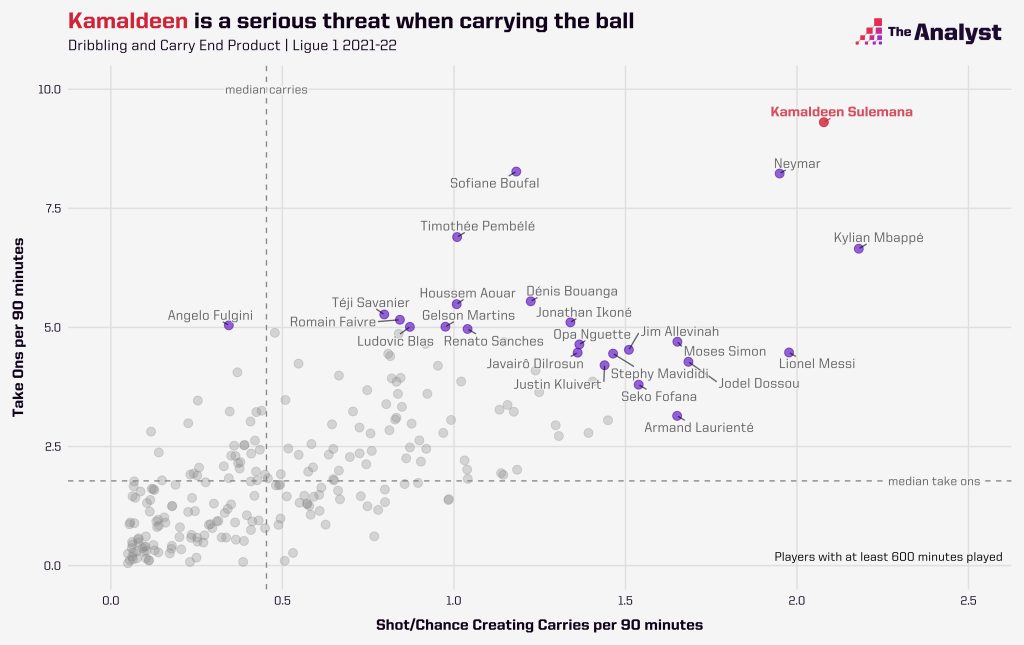
His dribbling also helps Rennes move the ball into dangerous areas. Among players with 900 minutes or more, Kamaldeen tops the league with carries into the box per 90 minutes, with 0.63. Most of his carries resulting in him shooting involve him cutting inside from the left, creating space for himself, and taking a shot from right outside the box or from the wider areas of the box. His ability to create shots for himself on his own from his dribbling is a very valuable skill that can serve him well in different situations.
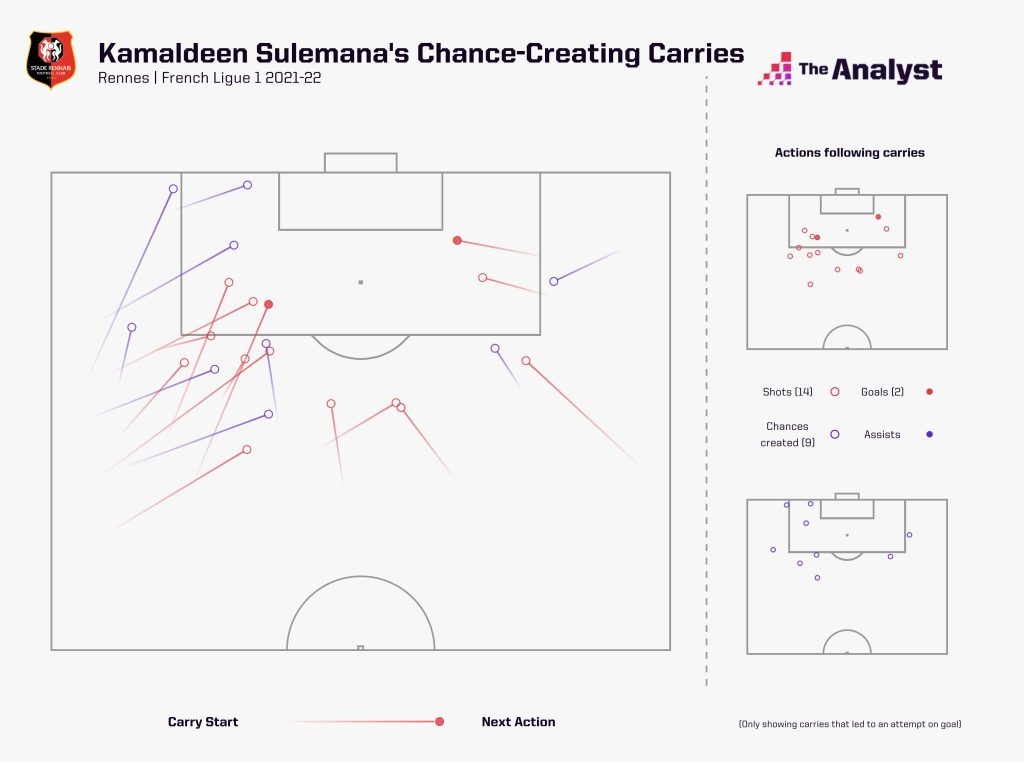
Beyond the stats, Kamaldeen’s technique and speed help him excel at the many different kinds of dribbles you’d desire in an attacker’s arsenal. He carries the ball very quickly into open space, but also keeps the ball well under pressure in tight spaces. He’s great at one-on-ones closer to the touchline with a full back to the side or in front of him, but carries the ball skilfully through central areas under 360° pressure, too. He can dribble at full speed in one direction to outrun a defender, but can also modulate his speed and change direction to outsmart a defender.
When he carries the ball in the opposition half against a set defence, Kamaldeen, similar to other elite close-control dribblers, attracts defenders who look to close him down, unsettling the defence and creating space for his teammates to attack. While it’s difficult to quantify this directly without player tracking data, each time he gets on the ball and moves forward with it, the attack just seems more likely to create a valuable chance. Here’s an example against Lorient, where he gets past one opponent and draws in three more defenders, creating space for his teammates to exploit.
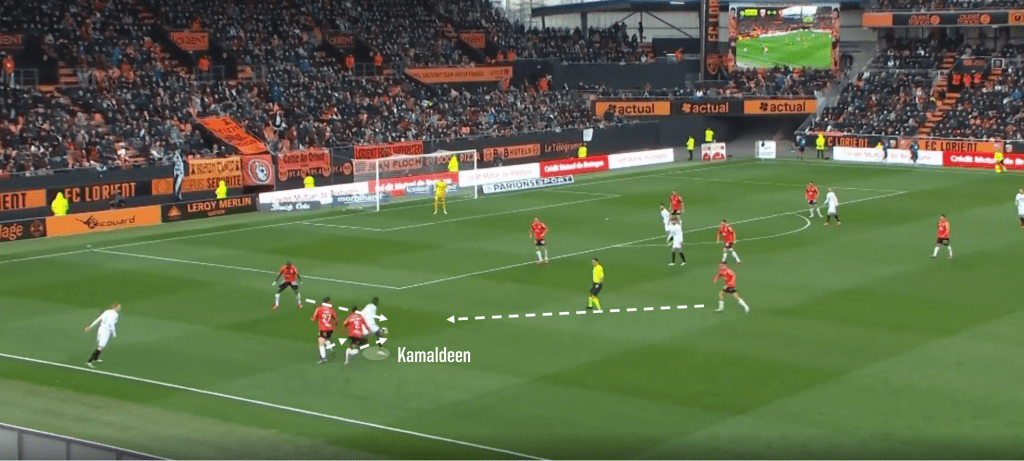
When he has the ball just wide of the box, a common move of his – something that his then-teammate at Nordsjælland Abu Francis acknowledged in a video with Kamaldeen breaking down their game – is faking a cut inside and then moving back outside towards the by-line to deliver a cutback.
Lastly, Kamaldeen’s dribbling is a big asset to Rennes’ counter-attacks as an outlet. His ball retention helps him consolidate possession after Rennes win the ball, he can carry the ball a long way up the pitch quickly and is direct and fast when attacking open space.
With Kamaldeen’s dribbling skill, it’s no mystery why he receives (over-the-top) comparisons to Ronaldinho and Neymar. It’s a lot more than just eye-candy, too. Each time he gets on the ball and carries it, he can create shooting opportunities and space, progress the ball into threatening positions, and improve a side’s attack by a big margin.
Movement and Positioning
While Kamaldeen spends a lot of time with the ball at his feet, he’s also a major attacking threat without the ball. He attacks open space with well-timed runs that make him look even faster than he already is, positions himself well relative to where his teammates are, and escapes the marker with quick, clever changes in direction and speed. Although Kamaldeen looks comfortable receiving in the inside channels too, at Rennes, he generally starts out wide, on the outside of the opposition right back, and receives close to the touchline. This is evident when you look at where he’s received the ball this season.
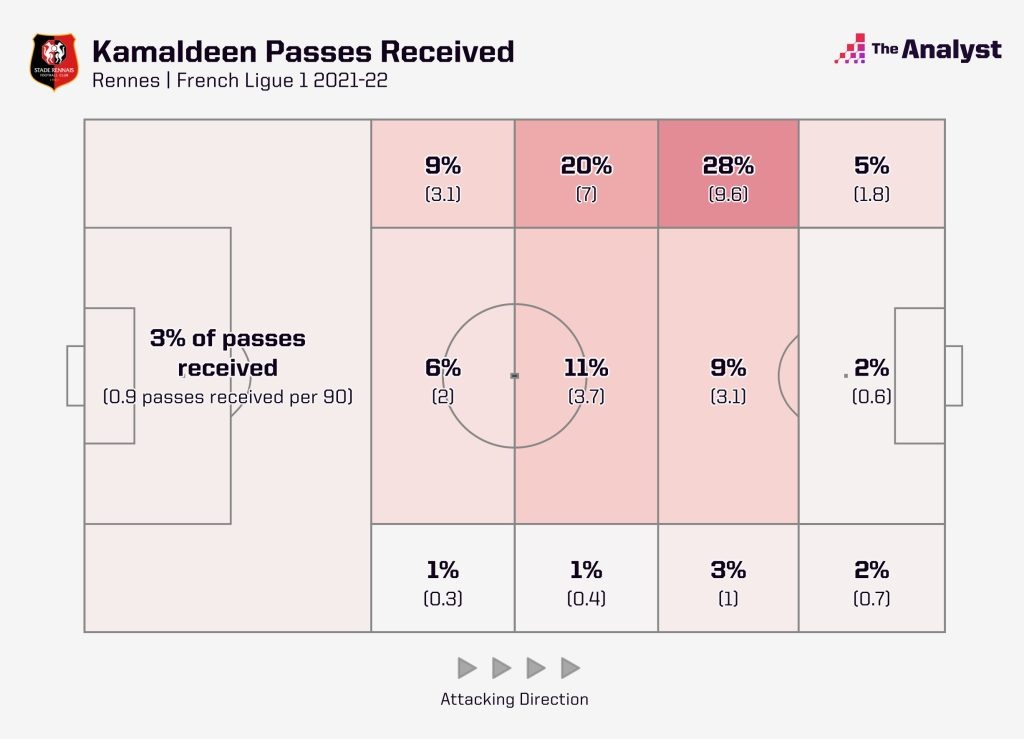
His incisive movement makes him a suitable target of longer, progressive passes from deep, as shown by the map of the forward passes he’s received in the final third.
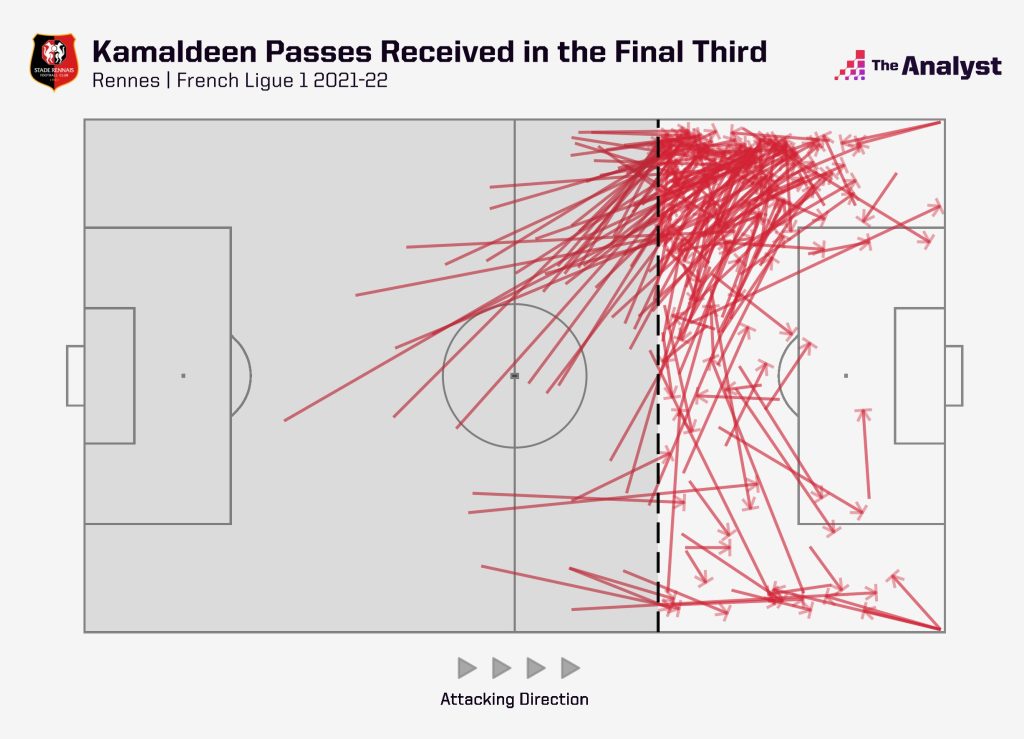
Kamaldeen takes part in Rennes’ positional rotations well, dropping deep to drag out defenders and create space for teammates. Here’s an example, where he drops deep, also attracting Lens’ right centre back out, creating space for then-teammate Eduardo Camavinga to attack.
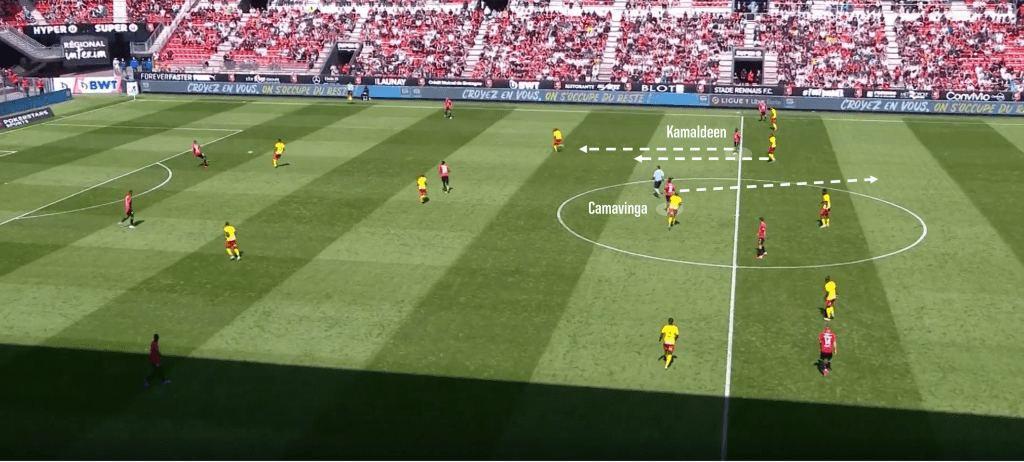
His movement also enables him to play one-two passes well with just solitary touches, for combination play and for creating chances for himself. The first goal of his brace against Clermont Foot is one example.
One manoeuvre Kamaldeen seems to make often is the curved run, starting in a position on the outside of the defender, usually the opposition right back, moving inside, and then curving his run back wide of the defender, where he receives the ball with space ahead close to the touchline to carry the ball into. His pace and timing enable him to change direction before the defender can catch up.
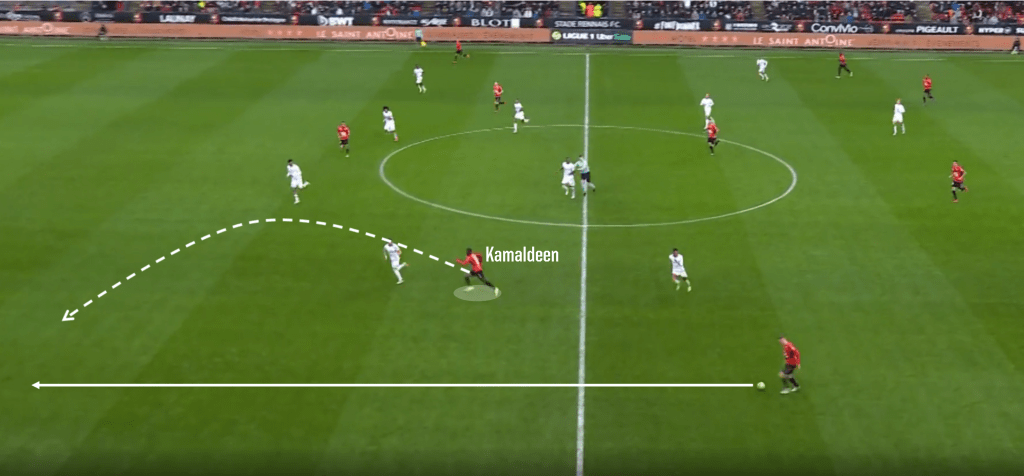
He also seems to spontaneously switch lanes and move centrally or to the right to attack open space.
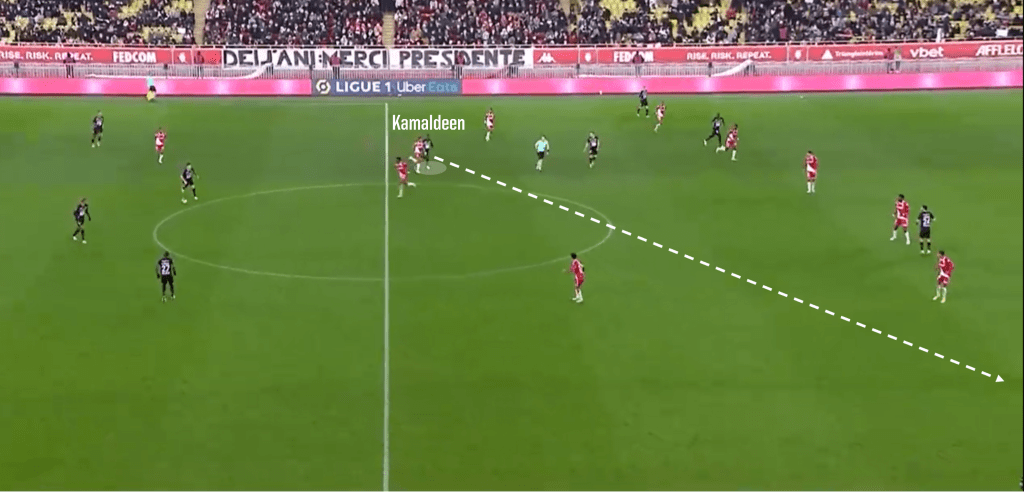
Finally, Kamaldeen is a big counter-attacking threat with his off-ball movement. He times his runs early and fills the right vertical lanes in transition. He has taken 0.27 shots per 90 from fast breaks, which is the sixth-highest in the league. An early example of his counter-attacking involvement is the goal he scored on his Rennes debut, against Lens.
All in all, Kamaldeen’s movement and positioning mean he doesn’t need the ball at his feet all the time to pose a threat to the opposition. This season so far, while his underlying numbers for goalscoring are only above-par, with 0.19 expected goals (xG) per 90 this season, compared to 0.35 xG per 90 last season in the Superliga, Kamaldeen’s movement indicates his potential to become a great goalscorer.
Shooting Behaviour
When he gets the ball in advanced areas, Kamaldeen seems intent on carrying it forward and going for goal. As a result, he ends up taking many speculative shots a long way away from goal, leading to attacks being wasted.
Last season, playing all across the frontline, Kamaldeen took a wide variety of shots, but far too many of them came from wide and far-out locations, with none of the shots from outside the box going in.
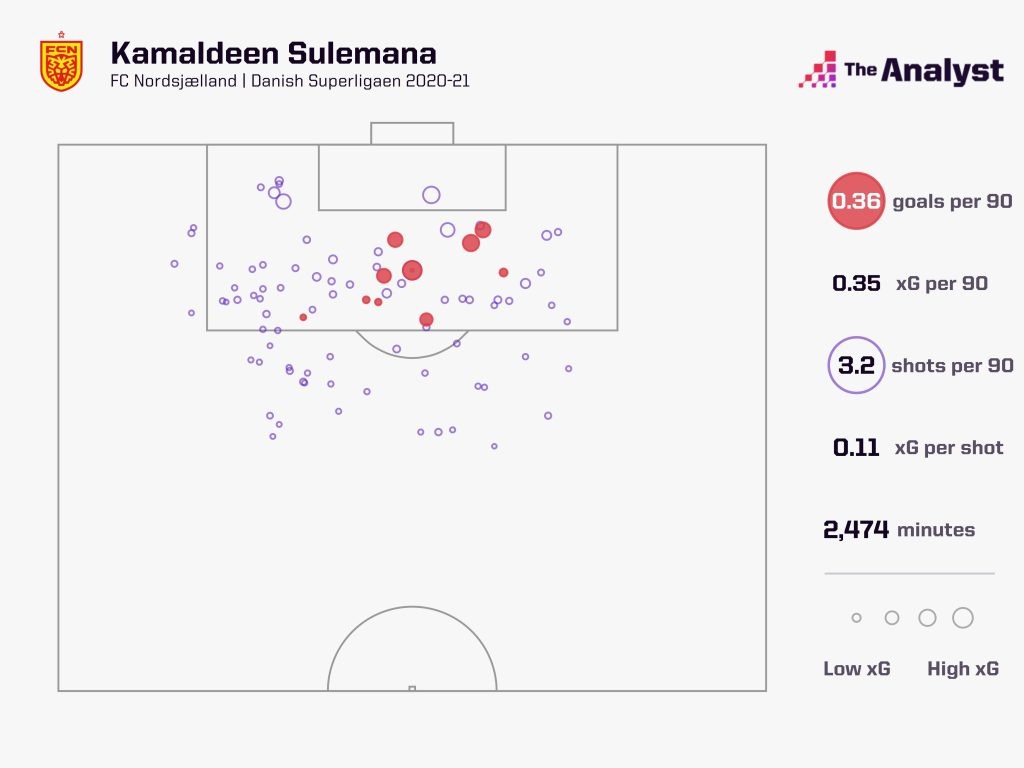
This season, even more of the shots he takes are from far-out and from wide areas, again, none of them going in. According to the underlying numbers, we’d expect him to score with just 8% of all the shots he’s taken this season for Rennes.
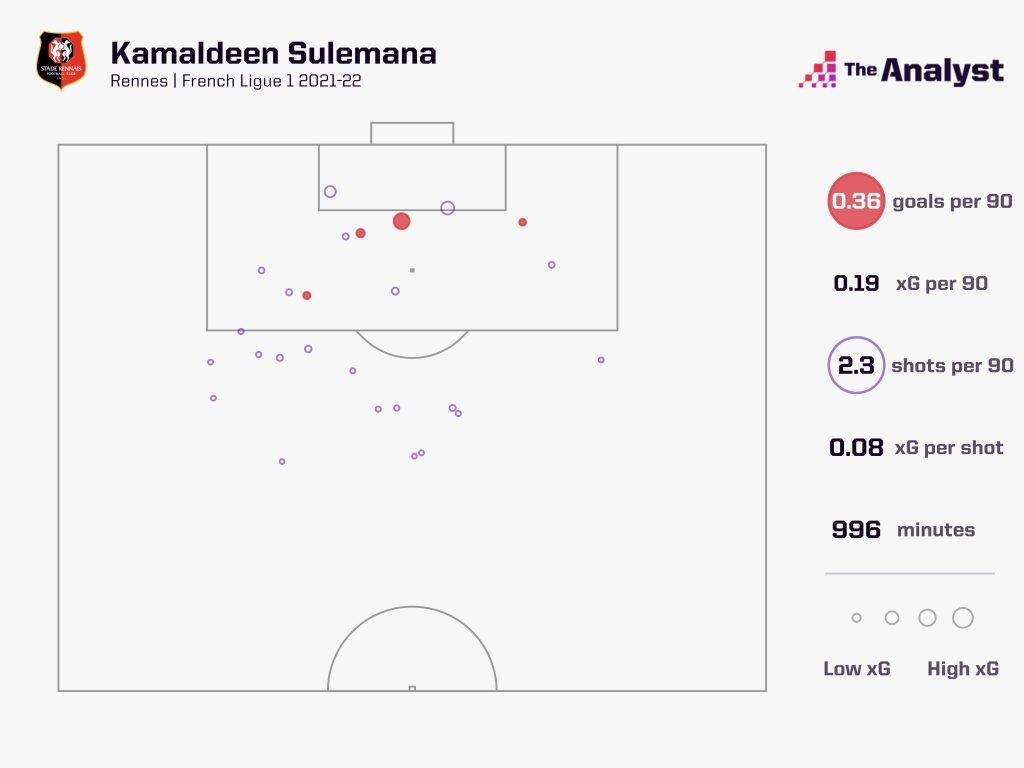
Because of the distance away from the goal these shots come from, 27.0% of Kamaldeen’s shots end up being blocked. Only 30.7% of his shots end up hitting the target. While he’s exhibited good shooting technique with the inside of his right foot in many of his finishes, a lot of the shots he does get on target end up in saveable areas.
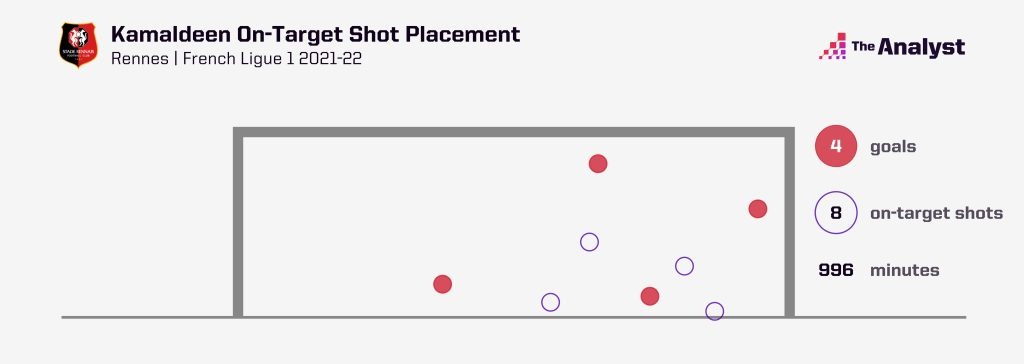
Every decision with the ball has an alternative. Many of these speculative shots have come from situations where there were other passing options, and his decisions to shoot instead have a high opportunity cost.
Long shots aren’t always inherently the wrong option, of course, even when they don’t go in. Tiago Estêvão in his piece ‘In Defense of Long Shots’ explains why well.
“From a macro perspective, these types of shots are also a useful means to force your opposition to defend outside of their own box. Using them to keep your offensive approach interchangeable and even as a decoy for other attacking moves is extremely important for a dominant side that spends most of the time in their attacking phase and needs to find diverse routes towards goal.” At the same time, however, Kamaldeen would create many more goals on aggregate if he opted to pass more when there were viable options.
By the looks of it, Kamaldeen’s only clear deficiency at this stage is his shot selection, and at the end of the day, this is one of the smallest flaws a young winger can have. Especially considering the technical ability he possesses to make the best of a better decision or to pick an option most other players can’t execute, there’s no doubt that it’s something he can improve on very easily.
Creativity and Passing
Because of his tendency to shoot or to hold onto the ball instead of passing in and around the box, Kamaldeen’s chance creation numbers aren’t the greatest, with 0.15 expected assists (xA) per 90. This hypothetically roughly translates to just five to six assists over the course of the season if he played every minute. When it comes to passing into dangerous areas, Kamaldeen plays 3.7 passes into the box per 90, which shows a lot more promise. Despite where his direct shot assisting numbers are at this stage, it looks like Kamaldeen has lots of creative potential. As you can see in the data visualisation below, this season most of Kamaldeen’s assists of shots from inside the box are crosses and cutbacks, delivered from advanced positions.
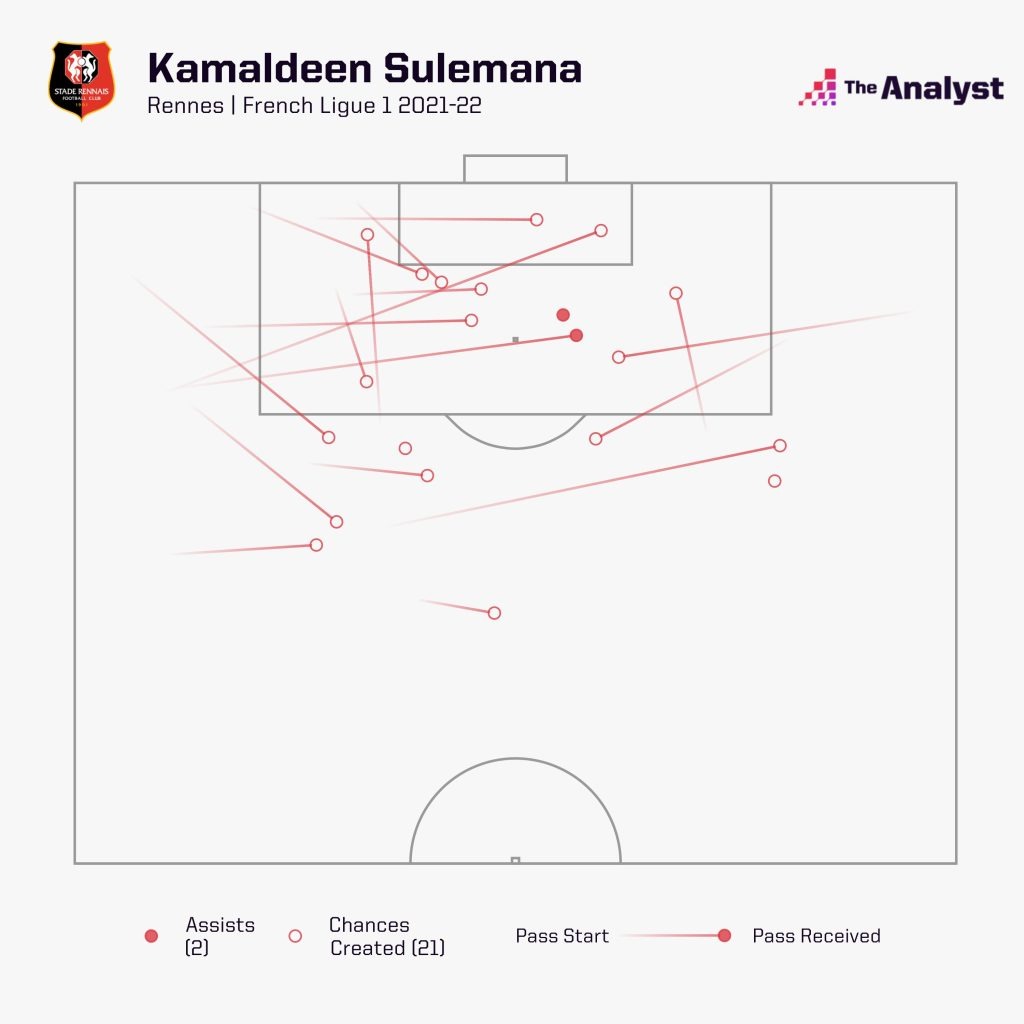
It was a similar story last season at FCN too, where he was also deployed on the right wing.
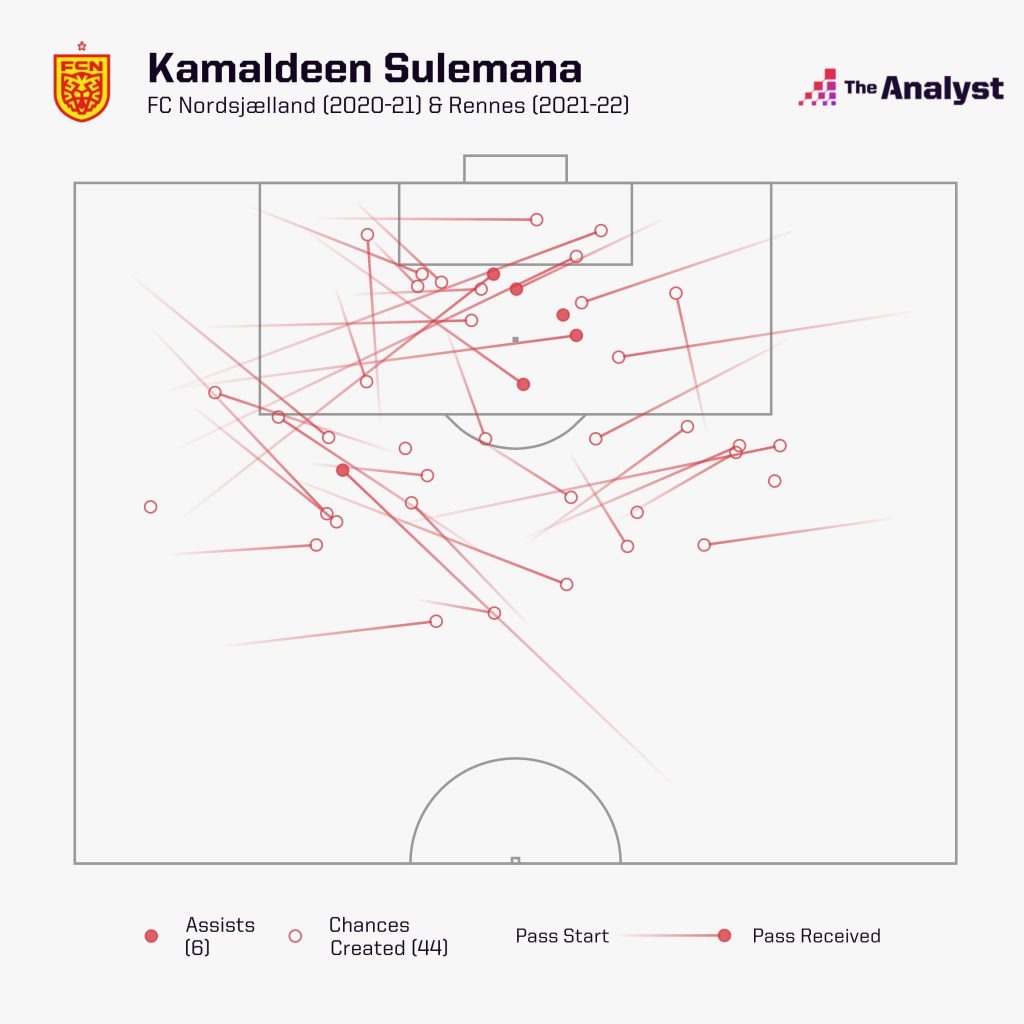
His dribbling skill and off-ball movement enable him to get high up the pitch, into good areas, and carve out space to deliver the final ball.
When delivering longer cross-field balls, it looks like Kamaldeen possesses good technique with his right foot, with the correct weight on his deliveries. An example is his assist against PSG, which topped off a great display against the league leaders.
He likes to switch the play into space created out wide on the opposite flank, generally to Benjamin Bourigeaud, which is helpful considering how he tends to draw defenders in with his dribbling. The fact that he attempts these switches quite often on international duty, too, points to this being a general trait of his, as opposed to a team instruction.
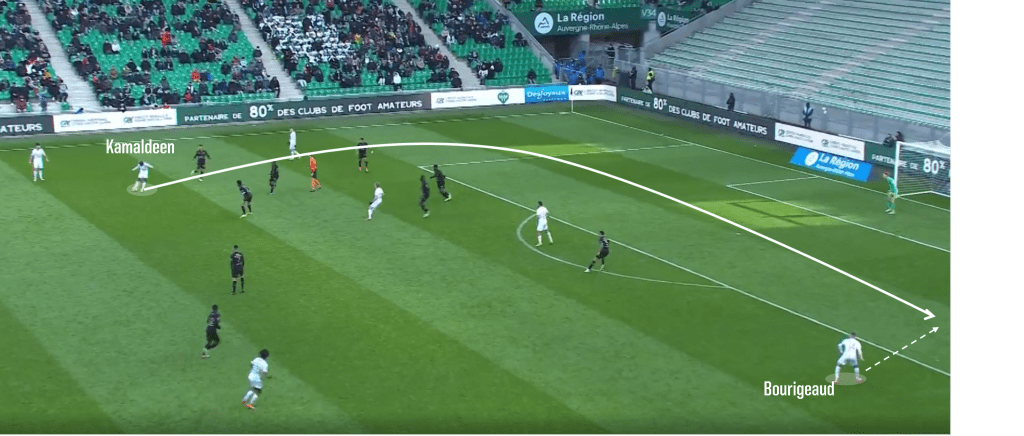
When not hampered by his overeagerness to go for goal, it does look like Kamaldeen has the prerequisites to create more opportunities for his teammates with his passing, and it’ll be interesting to see how his chance creation game grows over the next couple of years.
Pressing and Defensive Work
In addition to his undeniable individual brilliance, Kamaldeen is no slouch defensively. Positionally intelligent, athletic, and industrious, he’s a big part of Rennes’ press.
Generally, Rennes press moderately high, with the frontline usually pressing the backline man-for-man, attempting to win the ball by making a challenge as soon as an opposing player receives a pass. The upshot of this statistically is that Rennes allow the fourth-lowest passes per defensive action (PPDA) in the league with 11.1, and make the third-most high turnovers — possession regains within 40 metres of the opposition’s goal — with 8.9 per game. As a result of their tendency to tackle the receiver instead of intercepting the pass, Rennes attempt 1.87 times more tackles than interceptions, the third-highest ratio in the league.
Kamaldeen’s numbers show how big a part of Rennes’ press he is, and how often he wins the ball back for an attacker. The only forward who wins the ball back more than him in the final third is Ángel Di Maria. Kamaldeen wins the ball back in deeper areas, when Rennes settle into a midfield block, quite often, too.
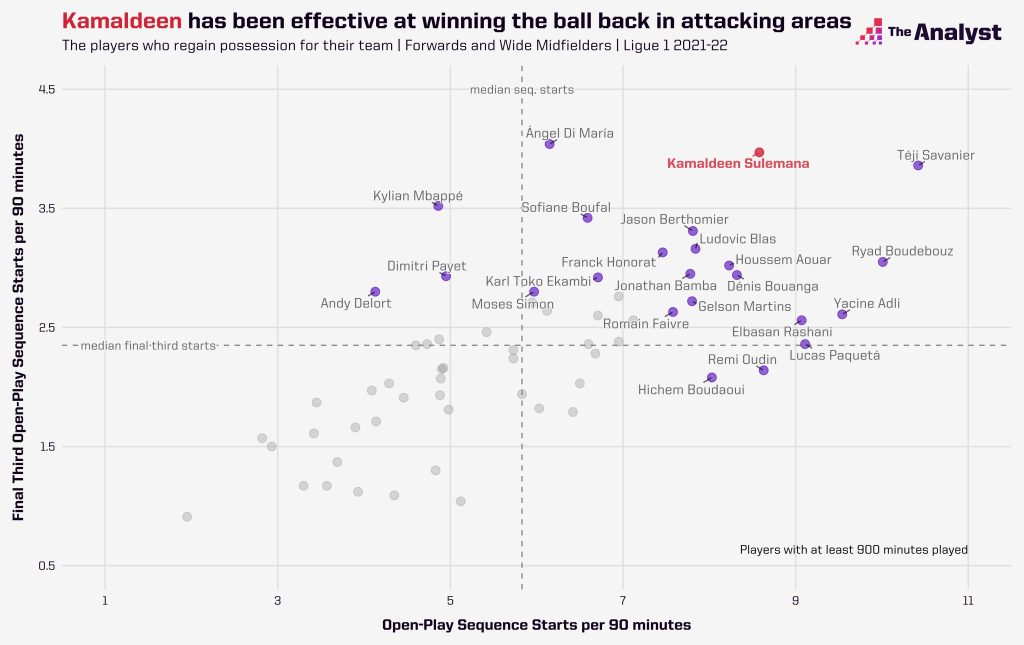
Presumably a function of Rennes’ pressing style, Kamaldeen makes lots of tackles for a winger, with 1.90 per 90, but makes just 0.36 interceptions per 90.
His pressing contribution goes beyond the instances where he won the ball himself, too. While not captured by on-ball event data, he cuts off passing lanes well, especially out wide, and constantly applies pressure that leads to a teammate winning the ball or resulting in the opponent playing a more conservative pass. In short, Kamaldeen’s a hard-working and effective cog in the press and is far from a luxury player.
How Far Can He Go?
Kamaldeen looks like the definition of a ‘high-ceiling’ talent. But at the same time, given the nature of his skill set, there’s the question of how scalable he is to bigger sides. Kamaldeen, with his ball-dominant, dribble-heavy style of play, is fundamentally a floor raiser. He also uses up many attacks by taking shots off dribbles from distance and by losing the ball quite often, which is a natural consequence of his high-risk, high-reward playing style. He looks most comfortable as a part of direct attacking sequences exploiting open space, too. Lastly, he also lacks experience at the very highest level of the game, and league effects may have influenced how good he looks. These are aspects that, hypothetically and intuitively, don’t scale up to better teams as well.
However, what’s clear is that he also possesses many qualities and traits that work very, very well at bigger sides. His movement, positioning, and speed mean he can flourish even without having as much of the ball. His close-control dribbling from deeper areas, his positioning, and his cross-field deliveries can help pry open the organised, set defences that bigger sides face. His defensive work and pressing contribution make him a great fit for any pressing system that requires work from its forwards. His wide range of skills also means he’s suited to the different kinds of tactical setups that big clubs use today, but perhaps fits transition-heavy tactics the best. And finally, his aforementioned proven skill against deeper defences, and his performance against PSG, make a case for his game translating well across leagues.
Of course, Kamaldeen still does look a few years away from the finished product and may need another season at Rennes before making the leap to a big club. He’ll definitely need to improve his decision making in and around the box and refine his creativity, but his direct and indirect goal contributions are likely to shoot up soon. Given his near mastery of dribbling and his pace, the absence of a clear limiting factor at the highest levels, and the fact that the next steps on the ladder are all aspects that wingers generally add to their game as they mature, he has a great chance of reaching the top tier of forwards in the game.
And what we do know for sure is how exciting-to-watch his journey to the top will be. It’s going to be one entertaining ride and one which we’ll all be tuning in to.
Enjoy this? Subscribe to our mailing list to receive exclusive weekly content.
Design by Ruben Dias.
